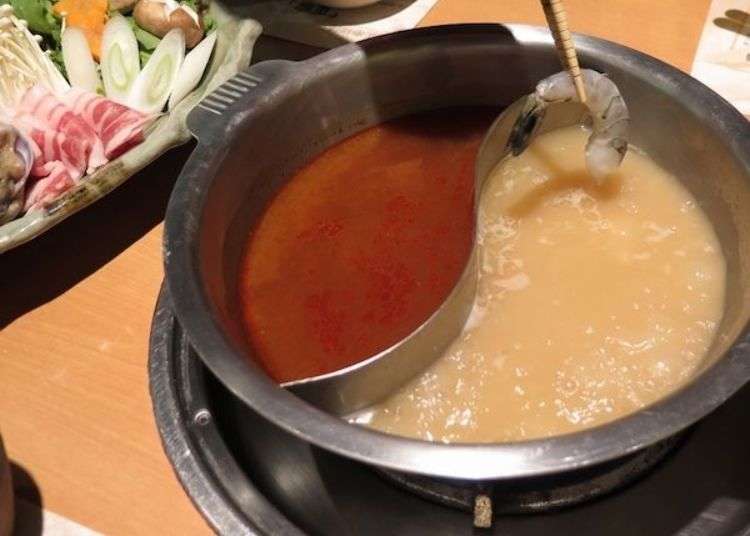
While the world is still discovering Japanese cuisine, many are becoming familiar with dishes that use sake, such as joyanabe (a kind of sake shabu-shabu) or bishonabe (hotpot flavored with sake).
The locals in Nada in Kobe (myself included) tend to think that it doesn’t really matter whether you have your sake chilled or warm with something as simple as a hotpot in winter. However, having recently heard about the ponshu-nabe menu served by a sake brewery in Nada, my curiosity was aroused. I went to the brewery last December to sample it.
I went out of Uozaki station on the Hanshin Electric Railway and walked south. As I passed under the bridge over National Highway 43 there was a sign that read, Uozaki Go. I turned left here and carried on. At the end of the road was a black wooden wall and a path lined with pine trees. Then I saw an imposing gate, set beneath a tiled roof with a cedarwood ball hanging down - a sugidama the mark of sake.
Sakuramasamune is one of the oldest breweries amongst the long-established sake breweries of the Nada Gogo group of breweries. The brewery’s ancient Edo period wooden storehouse wooden collapsed in the Great Hanshin Earthquake in 1995. This gate is now all that remains of the old building.
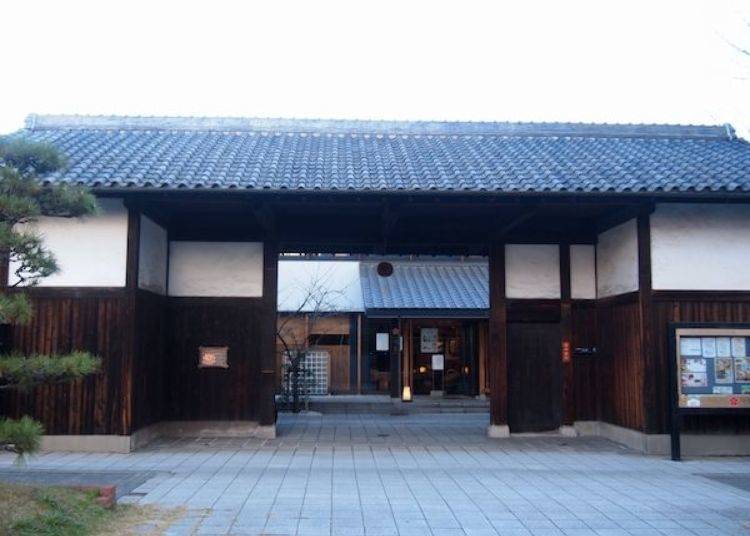
Sakuramasamune discovered Miyamizu, the famous spring water used for sake brewing
Sakuramasamune began brewing sake in Itami in Hyogo prefecture in 1625. The company was officially founded in 1717. However, its reputation doesn’t just stem from the fact that it is old and long-established.
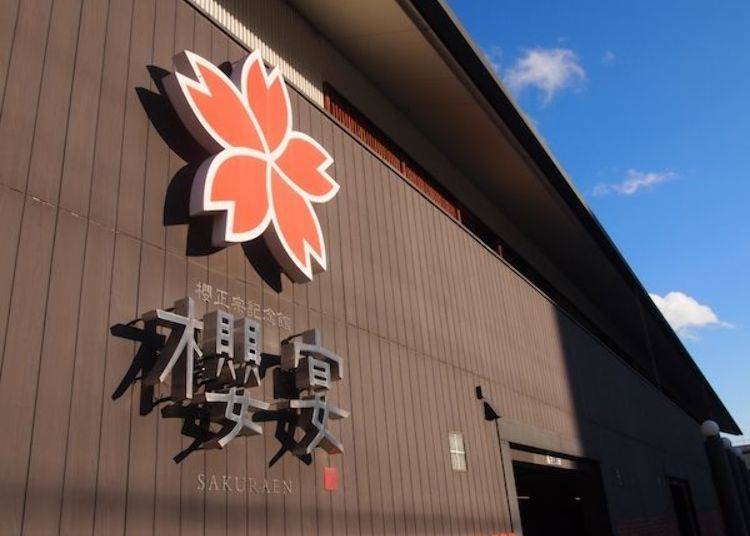
Tazaemon Yamamura, the sixth generation owner of the business, discovered Miyamizu—spring water from Mt. Rokko which wells up from underground beneath Nishinomiya. It is this water which gives Nada sake its distinct flavor.
He is also said to have invented the “Masamune” brand, which is known throughout Japan. In 1906, the brewery gained its first certification by the Brewing Society of Japan. Sake Yeast No. 1, which is used by sake brewers throughout Japan, is also a Sakuramasamune product. In other words, this prestigious brewery has made a huge contribution to the development of the Japanese sake industry.
I learn all this from the exhibition commentary and from Mr. Sho Shimoida, the manager of Sakuraen.
The characters for Masamune (“正宗”) were originally pronounced as “Seiyuu” which means “refined sake.” So the name references the fact that this is a place of refined sake. It’s an auspicious pun! However, when the company registered its tradename during the Meiji period, there were already a number of brands throughout Japan that included “Masamune” in their name. Mr. Shimoida tells me that sakura, Japan’s national flower, was therefore added to the name to make “Sakuramasamune.”

Traditional brewery items, such as casks, barrels and paddles are on display, along with old bottles and signs. There are beautiful cups and drinking vessels bearing the name Sakuramasamune or pictures of cherry blossoms. There are fascinating exhibits all over the museum, bringing life to the layers of history of this long-established brewery. The structure has been rebuilt using wood materials from the original building that collapsed during the earthquake. There’s also a Japanese restaurant, a cafe and a shop, so this is a place where you can spend time and browse at your leisure.
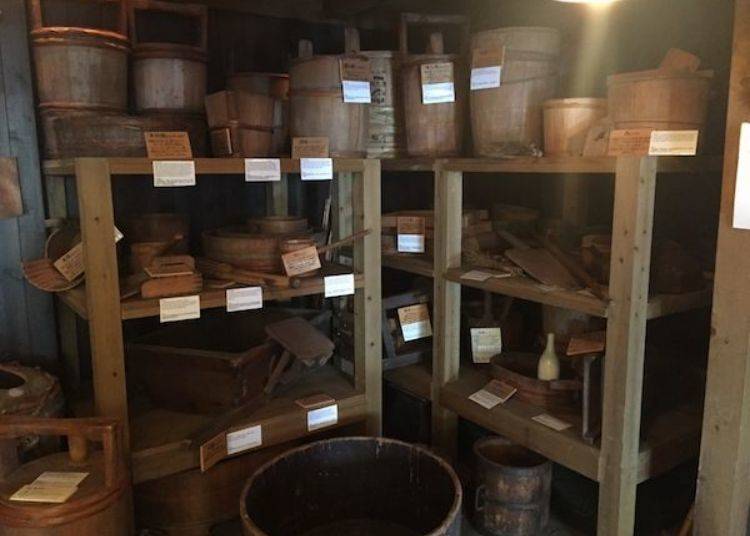
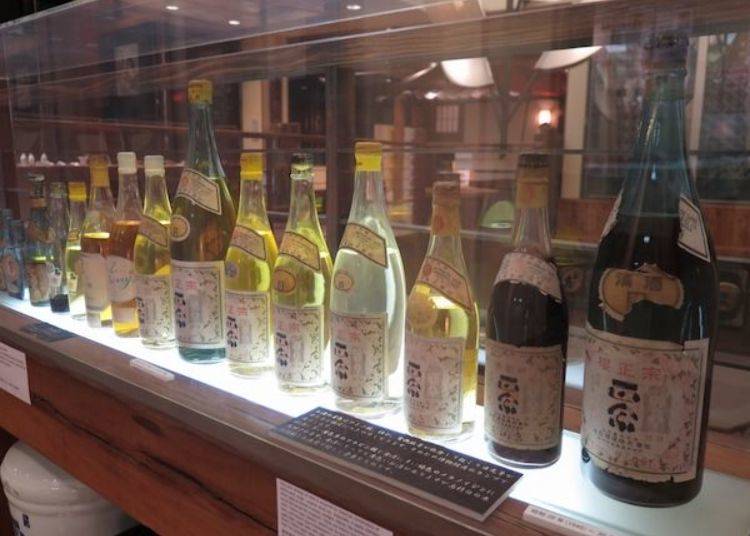
“The brewery is easily accessible by public transport from Uozaki Station. Not many authentic breweries round here offer fine dining, so we get a lot tourists visiting here. In recent years, we’ve had tour parties coming here directly by bus from Kansai Airport. They eat lunch and then go for a walk round the brewery,” explains Mr. Shimoida.

I make my way to the dining room, which is the purpose of my visit! I’m going to sample the Ponshu-nabe Tasting Menu, which is Sakuraen’s specialty meal. I can’t wait to taste it!
Enjoy a hotpot dish with two choices of richly flavored soup
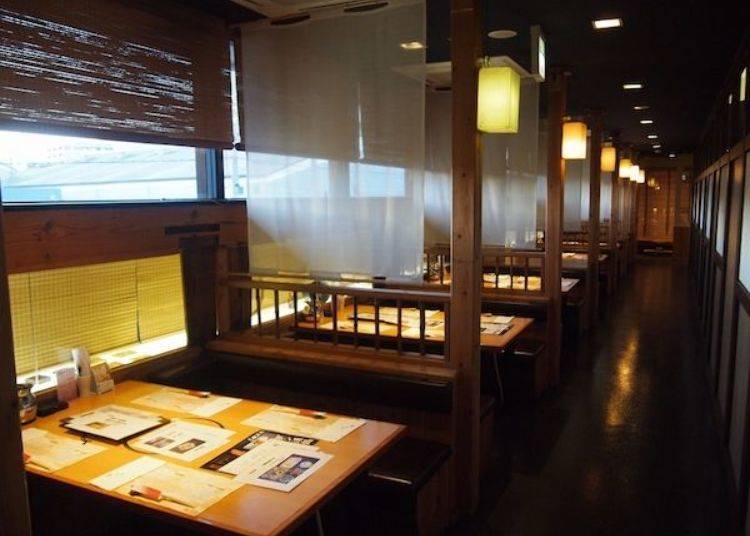
As the name suggests, ponshu-nabe is a hotpot dish made with a copious amount of sake. For the tasting menu, you choose two out five different flavors (plain, soymilk, spicy, sake lees, sesame, or chili oil.) I didn’t really know what to choose, but I went for spicy and sake lees. I like the idea of two contrasting colors and flavors in the nabe dish, and since I’m at a brewery, it surely makes sense to try the sake lees!
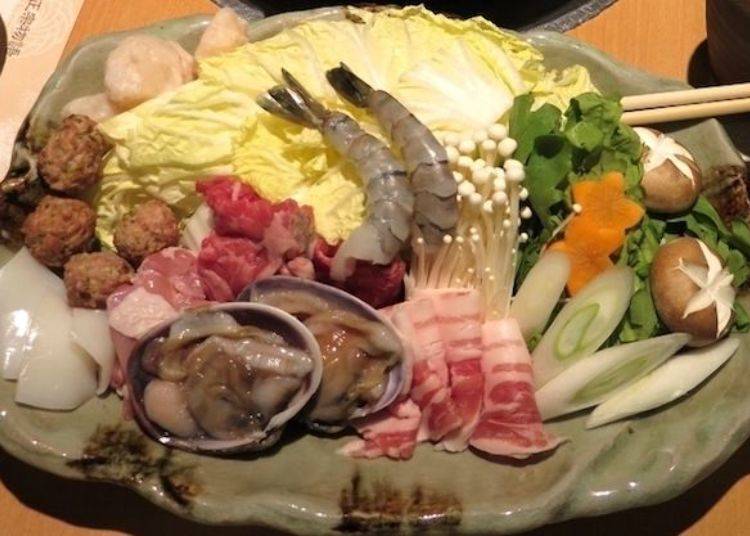
The ingredients for the hotpot are beef, pork, chicken, prawns, squid, shellfish, and plenty of vegetables, such as Chinese cabbage, white leek, and shiitake mushrooms. There is everything I need to make a really luxurious soup!
You can switch the vegetables as you wish to other options such as lettuce, watercress or Chinese water spinach. You can also choose various sakes to go with your meal, including the brewery’s very own unprocessed sake (sold by volume).
The Junmai Ginjo comes straight from the warehouse directly opposite the restaurant. The fresh taste of unpasteurized sake is very appealing.
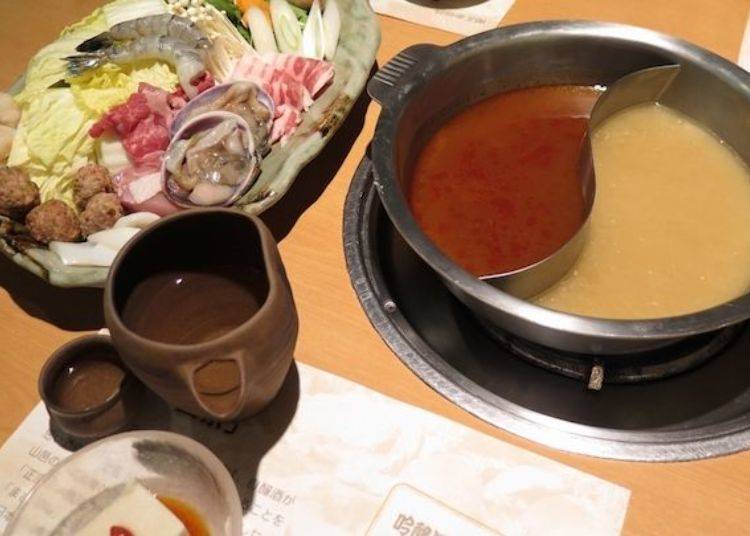
I start with the sake lees soup. It’s not thick and rich like a country style sake lees soup, but quite thin, adding a delicate and pleasant sake aroma to the meat and vegetables.
The alcohol is burned off by the heat, so I don't need to worry about any after effects from eating this. The food cooks quickly and is so easy to eat. The soup goes well with any ingredients, but the shellfish, squid and shiitake mushroom taste especially good with it.
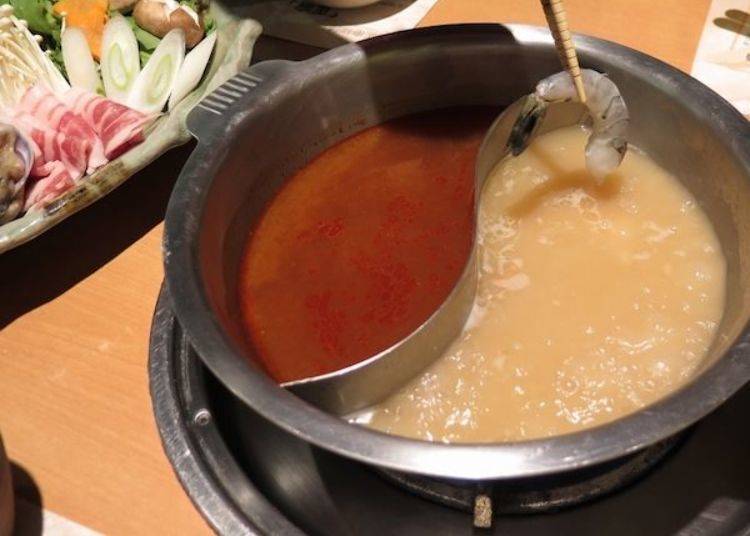
The spicy soup is a great match for any meat or for the white leeks and Chinese cabbage. The spiciness is more subtle than you’d expect.
Just as when you want to try some shochu or chuhai when you’re eating Korean hotpot, with this dish, I wanted to drink sake. It just felt like the perfect accompaniment. The full-bodied soup base is rich in flavor, so the food and the sake match each other well.
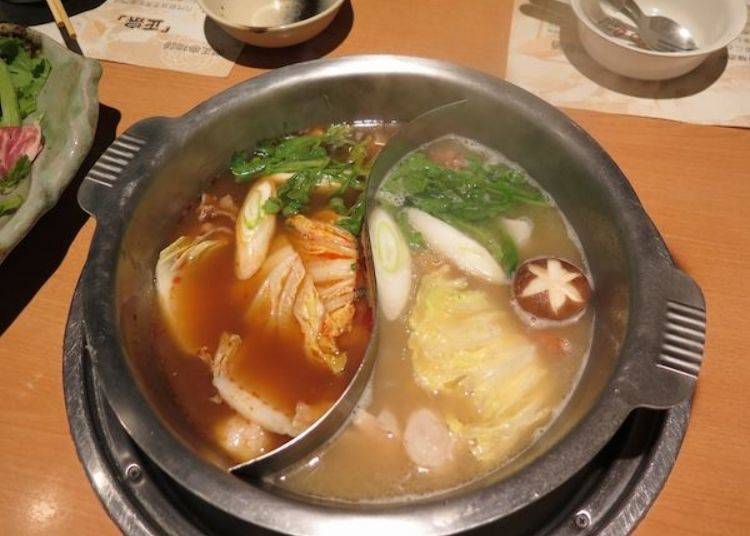
“The soup base is flavored with sardine bouillon or chicken bones. For the liquid, we use a mixture half water half sake. The sake imparts a pleasant flavor and helps soften the meat. We add ingredients such as sake lees or red chili miso to the soup base to vary the flavors,” says Tetsu Takahashi, who first came up with the idea for ponshu-nabe.
When Sakuraen was refurbished around five years ago, we tried various dishes incorporating sake. At the concept phase, we had a whole variety of different soups, but I whittled these down to five different types. So this is what we’ve come up with as a hotpot dish for sake.
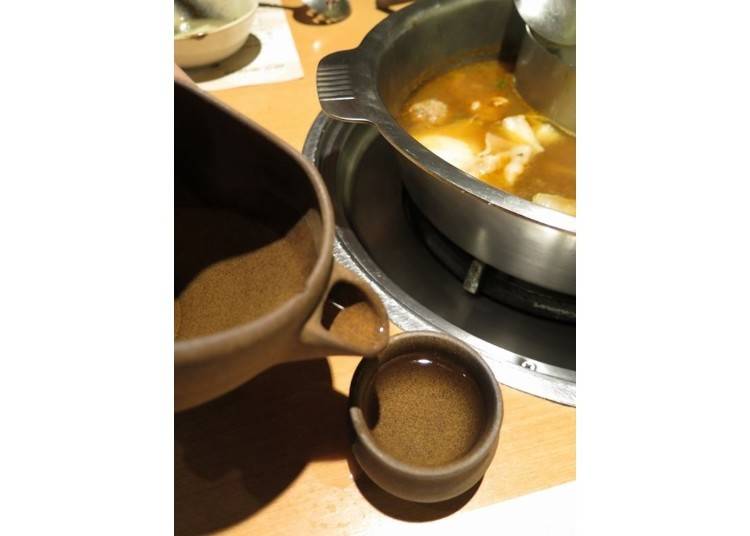
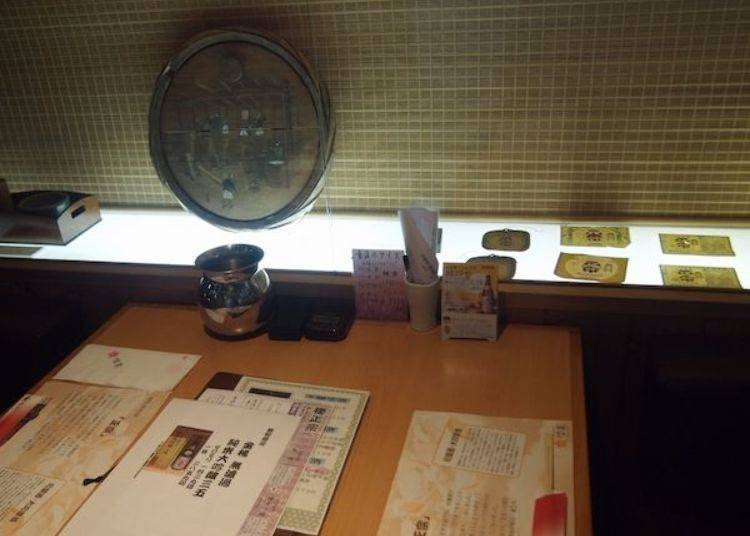
At the end of the meal you can choose either rice porridge, udon noodles or Chinese noodles to eat with the leftover soup. I chose rice porridge, which is a standard accompaniment. Incidentally, the most popular soup combination is plain and spicy.
“If there’s a group of you, you can choose different flavors for each table and try all the different ingredients with a little bit of each soup,” says Mr. Shimoida.
I see what he means. I want to try all the different combinations just to see what each one is like. Ponshu-nabe is served all year round so I’ll be back here soon.

I live in Nishigo near Nada Goro, so this is definitely somewhere I’ll come back to. It’s easy to get here on the Hanshin Electric Railway whether you live locally or come from far away.
*All prices exclude tax. (A service charge applies for all food and drink after 5:00PM).
-
Sakuramasamune Museum Sakuraen櫻正宗記念館 櫻宴
- Address 4-3-18 Uozaki Minamimachi, Higashinada Ward, Kobe, Hyogo Prefecture
- Phone Number 078-436-3030
Opening hours: 11:30AM - 3:00PM/5:00PM-10:00PM (Sanbaiya is only open in the evenings)
Closed: Tuesday
Text by:140B
- Area
- Category
*Prices and options mentioned are subject to change.
*Unless stated otherwise, all prices include tax.
Popular Tours & Activitiess
Recommended places for you
-

MOTSUHIKONambaamemura
Nabe
Namba, Dotonbori, Shinsaibashi
-

OOYAMA Umedachayamachi
Nabe
Umeda, Osaka Station, Kitashinchi
-

Oyama Rinkusuumeda
Nabe
Umeda, Osaka Station, Kitashinchi
-

OOYAMA Osakaeki
Nabe
Umeda, Osaka Station, Kitashinchi
-

ShinsekaimotsunabeyaNamba
Nabe
Namba, Dotonbori, Shinsaibashi
-

Oyama Nambapakusu
Nabe
Namba, Dotonbori, Shinsaibashi
-
Ad

Experiencing Manga as Culture, Not Just Reading It: Expo 2025 with Rumiko Takahashi
-

Everything You Need to Know About teamLab Biovortex Kyoto (2025 Insider Guide)
by: Wemmy Chau
-

New Way to Reach Koyasan! Ride Nankai's 'GRAN Tenku' for a Heavenly Journey
by: Guest Contributor
-

Celebrate a Dreamy Barbapapa Christmas at JR Osaka Station's Twilight
by: Guest Contributor
-
Ad

Discover Timeless Beauty: Kimono-en, a Web Magazine Exploring the Spirit of Kimono
-

A First Look at NEMU RESORT’s 2026 Grand Renewal in Ise-Shima: A Resort Shaped by Village, Sea, and Forest
by: Guest Contributor
Inspiration for Accommodations
-

Spacious Family Hotel in Namba: 20 Comfortable Stays for Family Fun
-

Charming Hotels to Enjoy the Spectacular Views of Arashiyama's Autumn Leaves from Your Room
-

Experience Stunning Views of Osaka Castle from Private Spaces: Top Hotels Near Osaka Castle
-

Recommended by Visitors! Arashiyama's Best-Rated Hotels
-

Family-Friendly Universal Studios Japan Hotel with Excellent Access
-

Enjoy a Comfortable Stay in Osaka! 10 Hotels with Convenient Airport Shuttle Services
-

Top 10 Recommended Hotels Near Namba Station with Great Access
-

Enjoy Night Views from Your Room! Recommended Hotels in Namba Area
-

The Best of Japan: 11 Major Cities Every Traveler Should Visit
-

Healthcare in Japan for Tourists: What to Do When You Get Sick or Injured in Japan
-

Osaka Koreatown: In Search of the Best Eats in the Korean Roots of Osaka's Tsuruhashi Market
-

10 Best Hotels Near Kyoto Station: Budget-friendly, Perfect for Kyoto Sightseeing
-

3 Best Izakaya In Osaka Where You Can Enjoy Drinks and Local Dishes, Recommended by Locals
-

Inside Kobe Tower: Fun Things to Do at the Symbol of Kobe
- #best gourmet Osaka
- #things to do Osaka
- #what to do in kyoto
- #what to bring to japan
- #best gourmet Kyoto
- #new years in Osaka
- #what to buy in nanba
- #Visiting Osaka
- #onsen tattoo friendly arima
- #daiso
- #Visiting Kyoto
- #best japanese soft drinks
- #japanese fashion culture
- #japanese convenience store snacks
- #japanese nail trends












